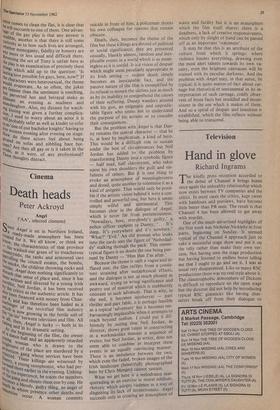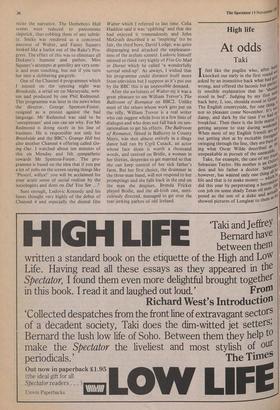Television
Hand in glove
Richard Ingrams
The kindly press reception accorded to the debut of Channel 4 brings home once again the unhealthy relationship which now exists between TV companies and the critics. In most cases the critics, kept sweet with handouts and previews, have become little better than PR men. The result is that Channel 4 has been allowed to get away with murder.
One of the much-advertised highlights of the first week was Nicholas Nickleby in four parts, beginning on Sunday. It seemed typical of the Channel 4 approach just to take a successful stage show and put it on the telly rather than make their own ver- sion. Not having seen the stage production but having listened to endless bores telling me that I ought to go and see it, I was as usual very disappointed. Like so many RSC productions there was no real style about it. The claustrophobic atmosphere of Dickens is difficult to reproduce on the open stage but the director did not help by introducing typical RSC gimmicks like having char- acters break off from their dialogue to
recite the narrative. The Dotheboys Hall scenes were reduced to pantomime slapstick, thus robbing them of any subtle- ty. Smike was rendered as a contorted ancestor of Walter, and Fanny Squeers looked like a harlot out of the Rake's Pro- gress. The effect of this was to elitninate all Dickens's humour and pathos. Miss Squeers's attempts at gentility are very com- ic and even touching, but not if you turn her into a slobbering gargoyle.
One of the Channel 4 programmes which I missed on the opening night was Brookside, a serial set on Merseyside, writ- ten and produced by one Phil Redmond. This programme was later in the news when the director, George Spenton-Foster, resigned as a protest against the bad language. Mr Redmond was said to be `unrepentant' and one can see why. For Mr Redmond is doing nicely in his line of business. He is responsible not only for Brookside and the BBC's Grange Hill but also another Channel 4 offering called Go- ing Out. I watched about ten minutes of this on Monday and felt sympathetic towards Mr Spenton-Foster. The pro- gramme is based on the idea that if you put a lot of yobs on the screen saying things like `Pissorf, willya!' you will be acclaimed for your acute sense of social realism by the sociologists and dons on Did You See ..?
Sure enough, Ludovic Kennedy and his bores thought very highly of the debut of Channel 4 and especially the dismal film Walter which I referred to last time. Celia Haddon said it was 'uplifting' and that she had enjoyed it tremendously and John McGrath described it as 'inspiring' (to be fair, the third bore, David Lodge, was quite disparaging and attacked the unpleasant- ness of the asylum scenes). Ludovic himself seemed to think very highly of Five Go Mad in Dorset which he called 'a wonderfully surreal send-up'. As always, I wished that his programme could distance itself more from television but I suppose as it's put out by the BBC this is an impossible demand.
After the awfulness of Walter etc it was a great pleasure to see William Trevor's The Ballroom of Romance on BBC2. Unlike most of the others whose work gets put on the telly, William Trevor is a real writer who can suggest whole lives in a few lines of dialogue and who does not fall back on sen- sationalism to get his effects. The Ballroom of Romance, filmed in Ballicroy in County Mayo, was shot almost entirely in a dingy dance hall run by Cyril Cusack, an actor whose face alone is worth a thousand words, and centred on Bridie, a woman in her thirties, desperate to get married so that she can keep control of her sick father's farm. But her first choice, the drummer in the three-man band, will not respond to her promptings and she falls back in the end on the man she despises. Brenda Fricker played Bridie, and the all-Irish cast, meti- culously directed, managed to get over the tear-jerking pathos of old Ireland.















































 Previous page
Previous page